Can Wang
MSL: Not All Tokens Are What You Need for Tuning LLM as a Recommender
Apr 05, 2025Abstract:Large language models (LLMs), known for their comprehension capabilities and extensive knowledge, have been increasingly applied to recommendation systems (RS). Given the fundamental gap between the mechanism of LLMs and the requirement of RS, researchers have focused on fine-tuning LLMs with recommendation-specific data to enhance their performance. Language Modeling Loss (LML), originally designed for language generation tasks, is commonly adopted. However, we identify two critical limitations of LML: 1) it exhibits significant divergence from the recommendation objective; 2) it erroneously treats all fictitious item descriptions as negative samples, introducing misleading training signals. To address these limitations, we propose a novel Masked Softmax Loss (MSL) tailored for fine-tuning LLMs on recommendation. MSL improves LML by identifying and masking invalid tokens that could lead to fictitious item descriptions during loss computation. This strategy can effectively avoid the interference from erroneous negative signals and ensure well alignment with the recommendation objective supported by theoretical guarantees. During implementation, we identify a potential challenge related to gradient vanishing of MSL. To overcome this, we further introduce the temperature coefficient and propose an Adaptive Temperature Strategy (ATS) that adaptively adjusts the temperature without requiring extensive hyperparameter tuning. Extensive experiments conducted on four public datasets further validate the effectiveness of MSL, achieving an average improvement of 42.24% in NDCG@10. The code is available at https://github.com/WANGBohaO-jpg/MSL.
Recent Advances on Generalizable Diffusion-generated Image Detection
Feb 27, 2025Abstract:The rise of diffusion models has significantly improved the fidelity and diversity of generated images. With numerous benefits, these advancements also introduce new risks. Diffusion models can be exploited to create high-quality Deepfake images, which poses challenges for image authenticity verification. In recent years, research on generalizable diffusion-generated image detection has grown rapidly. However, a comprehensive review of this topic is still lacking. To bridge this gap, we present a systematic survey of recent advances and classify them into two main categories: (1) data-driven detection and (2) feature-driven detection. Existing detection methods are further classified into six fine-grained categories based on their underlying principles. Finally, we identify several open challenges and envision some future directions, with the hope of inspiring more research work on this important topic. Reviewed works in this survey can be found at https://github.com/zju-pi/Awesome-Diffusion-generated-Image-Detection.
Trunk-branch Contrastive Network with Multi-view Deformable Aggregation for Multi-view Action Recognition
Feb 23, 2025Abstract:Multi-view action recognition aims to identify actions in a given multi-view scene. Traditional studies initially extracted refined features from each view, followed by implemented paired interaction and integration, but they potentially overlooked the critical local features in each view. When observing objects from multiple perspectives, individuals typically form a comprehensive impression and subsequently fill in specific details. Drawing inspiration from this cognitive process, we propose a novel trunk-branch contrastive network (TBCNet) for RGB-based multi-view action recognition. Distinctively, TBCNet first obtains fused features in the trunk block and then implicitly supplements vital details provided by the branch block via contrastive learning, generating a more informative and comprehensive action representation. Within this framework, we construct two core components: the multi-view deformable aggregation and the trunk-branch contrastive learning. MVDA employed in the trunk block effectively facilitates multi-view feature fusion and adaptive cross-view spatio-temporal correlation, where a global aggregation module is utilized to emphasize significant spatial information and a composite relative position bias is designed to capture the intra- and cross-view relative positions. Moreover, a trunk-branch contrastive loss is constructed between aggregated features and refined details from each view. By incorporating two distinct weights for positive and negative samples, a weighted trunk-branch contrastive loss is proposed to extract valuable information and emphasize subtle inter-class differences. The effectiveness of TBCNet is verified by extensive experiments on four datasets including NTU-RGB+D 60, NTU-RGB+D 120, PKU-MMD, and N-UCLA dataset. Compared to other RGB-based methods, our approach achieves state-of-the-art performance in cross-subject and cross-setting protocols.
Subpixel Edge Localization Based on Converted Intensity Summation under Stable Edge Region
Feb 23, 2025Abstract:To satisfy the rigorous requirements of precise edge detection in critical high-accuracy measurements, this article proposes a series of efficient approaches for localizing subpixel edge. In contrast to the fitting based methods, which consider pixel intensity as a sample value derived from a specific model. We take an innovative perspective by assuming that the intensity at the pixel level can be interpreted as a local integral mapping in the intensity model for subpixel localization. Consequently, we propose a straightforward subpixel edge localization method called Converted Intensity Summation (CIS). To address the limited robustness associated with focusing solely on the localization of individual edge points, a Stable Edge Region (SER) based algorithm is presented to alleviate local interference near edges. Given the observation that the consistency of edge statistics exists in the local region, the algorithm seeks correlated stable regions in the vicinity of edges to facilitate the acquisition of robust parameters and achieve higher precision positioning. In addition, an edge complement method based on extension-adjustment is also introduced to rectify the irregular edges through the efficient migration of SERs. A large number of experiments are conducted on both synthetic and real image datasets which cover common edge patterns as well as various real scenarios such as industrial PCB images, remote sensing and medical images. It is verified that CIS can achieve higher accuracy than the state-of-the-art method, while requiring less execution time. Moreover, by integrating SER into CIS, the proposed algorithm demonstrates excellent performance in further improving the anti-interference capability and positioning accuracy.
Uncertainty-Aware Graph Structure Learning
Feb 19, 2025Abstract:Graph Neural Networks (GNNs) have become a prominent approach for learning from graph-structured data. However, their effectiveness can be significantly compromised when the graph structure is suboptimal. To address this issue, Graph Structure Learning (GSL) has emerged as a promising technique that refines node connections adaptively. Nevertheless, we identify two key limitations in existing GSL methods: 1) Most methods primarily focus on node similarity to construct relationships, while overlooking the quality of node information. Blindly connecting low-quality nodes and aggregating their ambiguous information can degrade the performance of other nodes. 2) The constructed graph structures are often constrained to be symmetric, which may limit the model's flexibility and effectiveness. To overcome these limitations, we propose an Uncertainty-aware Graph Structure Learning (UnGSL) strategy. UnGSL estimates the uncertainty of node information and utilizes it to adjust the strength of directional connections, where the influence of nodes with high uncertainty is adaptively reduced. Importantly, UnGSL serves as a plug-in module that can be seamlessly integrated into existing GSL methods with minimal additional computational cost. In our experiments, we implement UnGSL into six representative GSL methods, demonstrating consistent performance improvements.
DICE: Distilling Classifier-Free Guidance into Text Embeddings
Feb 06, 2025



Abstract:Text-to-image diffusion models are capable of generating high-quality images, but these images often fail to align closely with the given text prompts. Classifier-free guidance (CFG) is a popular and effective technique for improving text-image alignment in the generative process. However, using CFG introduces significant computational overhead and deviates from the established theoretical foundations of diffusion models. In this paper, we present DIstilling CFG by enhancing text Embeddings (DICE), a novel approach that removes the reliance on CFG in the generative process while maintaining the benefits it provides. DICE distills a CFG-based text-to-image diffusion model into a CFG-free version by refining text embeddings to replicate CFG-based directions. In this way, we avoid the computational and theoretical drawbacks of CFG, enabling high-quality, well-aligned image generation at a fast sampling speed. Extensive experiments on multiple Stable Diffusion v1.5 variants, SDXL and PixArt-$\alpha$ demonstrate the effectiveness of our method. Furthermore, DICE supports negative prompts for image editing to improve image quality further. Code will be available soon.
PSL: Rethinking and Improving Softmax Loss from Pairwise Perspective for Recommendation
Oct 31, 2024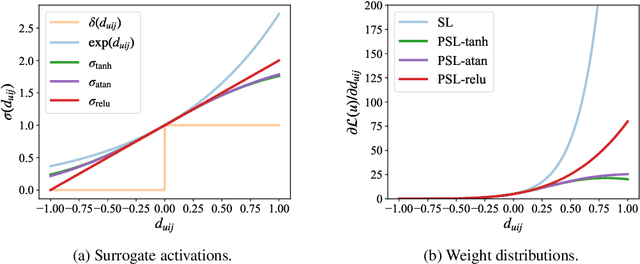
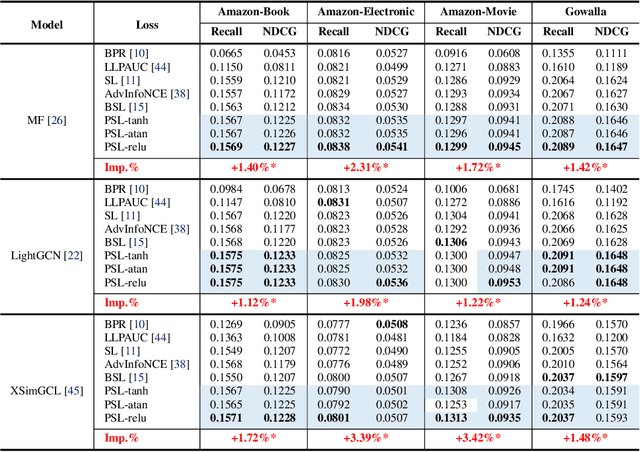
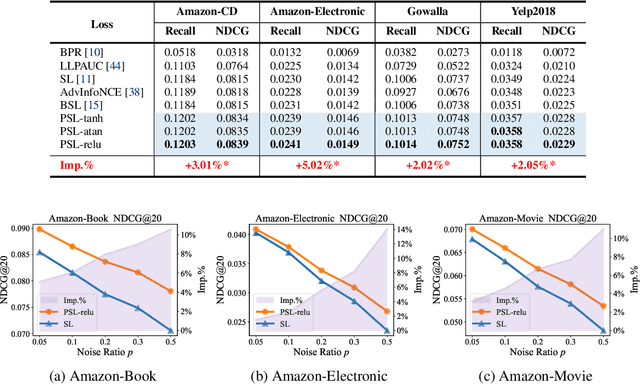

Abstract:Softmax Loss (SL) is widely applied in recommender systems (RS) and has demonstrated effectiveness. This work analyzes SL from a pairwise perspective, revealing two significant limitations: 1) the relationship between SL and conventional ranking metrics like DCG is not sufficiently tight; 2) SL is highly sensitive to false negative instances. Our analysis indicates that these limitations are primarily due to the use of the exponential function. To address these issues, this work extends SL to a new family of loss functions, termed Pairwise Softmax Loss (PSL), which replaces the exponential function in SL with other appropriate activation functions. While the revision is minimal, we highlight three merits of PSL: 1) it serves as a tighter surrogate for DCG with suitable activation functions; 2) it better balances data contributions; and 3) it acts as a specific BPR loss enhanced by Distributionally Robust Optimization (DRO). We further validate the effectiveness and robustness of PSL through empirical experiments. The code is available at https://github.com/Tiny-Snow/IR-Benchmark.
Plug-and-Play Performance Estimation for LLM Services without Relying on Labeled Data
Oct 10, 2024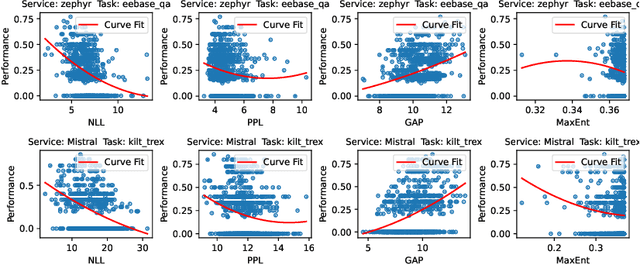
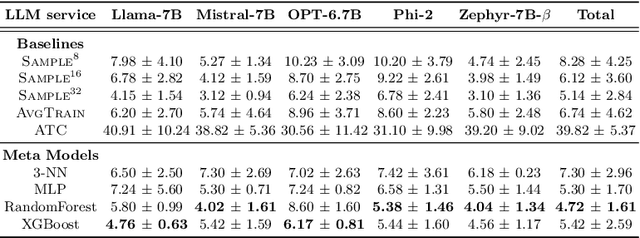
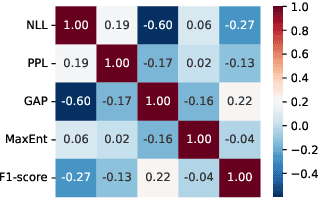

Abstract:Large Language Model (LLM) services exhibit impressive capability on unlearned tasks leveraging only a few examples by in-context learning (ICL). However, the success of ICL varies depending on the task and context, leading to heterogeneous service quality. Directly estimating the performance of LLM services at each invocation can be laborious, especially requiring abundant labeled data or internal information within the LLM. This paper introduces a novel method to estimate the performance of LLM services across different tasks and contexts, which can be "plug-and-play" utilizing only a few unlabeled samples like ICL. Our findings suggest that the negative log-likelihood and perplexity derived from LLM service invocation can function as effective and significant features. Based on these features, we utilize four distinct meta-models to estimate the performance of LLM services. Our proposed method is compared against unlabeled estimation baselines across multiple LLM services and tasks. And it is experimentally applied to two scenarios, demonstrating its effectiveness in the selection and further optimization of LLM services.
Towards Dynamic Graph Neural Networks with Provably High-Order Expressive Power
Oct 02, 2024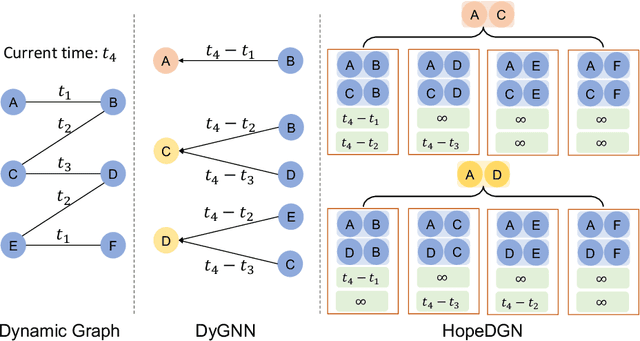
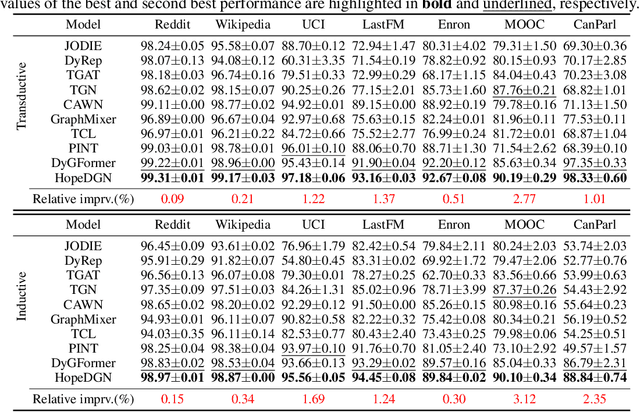

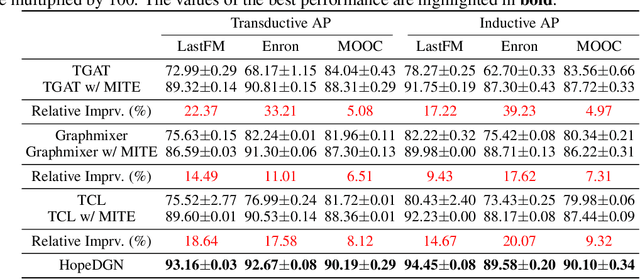
Abstract:Dynamic Graph Neural Networks (DyGNNs) have garnered increasing research attention for learning representations on evolving graphs. Despite their effectiveness, the limited expressive power of existing DyGNNs hinders them from capturing important evolving patterns of dynamic graphs. Although some works attempt to enhance expressive capability with heuristic features, there remains a lack of DyGNN frameworks with provable and quantifiable high-order expressive power. To address this research gap, we firstly propose the k-dimensional Dynamic WL tests (k-DWL) as the referencing algorithms to quantify the expressive power of DyGNNs. We demonstrate that the expressive power of existing DyGNNs is upper bounded by the 1-DWL test. To enhance the expressive power, we propose Dynamic Graph Neural Network with High-order expressive power (HopeDGN), which updates the representation of central node pair by aggregating the interaction history with neighboring node pairs. Our theoretical results demonstrate that HopeDGN can achieve expressive power equivalent to the 2-DWL test. We then present a Transformer-based implementation for the local variant of HopeDGN. Experimental results show that HopeDGN achieved performance improvements of up to 3.12%, demonstrating the effectiveness of HopeDGN.
Simple and Fast Distillation of Diffusion Models
Sep 29, 2024



Abstract:Diffusion-based generative models have demonstrated their powerful performance across various tasks, but this comes at a cost of the slow sampling speed. To achieve both efficient and high-quality synthesis, various distillation-based accelerated sampling methods have been developed recently. However, they generally require time-consuming fine tuning with elaborate designs to achieve satisfactory performance in a specific number of function evaluation (NFE), making them difficult to employ in practice. To address this issue, we propose Simple and Fast Distillation (SFD) of diffusion models, which simplifies the paradigm used in existing methods and largely shortens their fine-tuning time up to 1000$\times$. We begin with a vanilla distillation-based sampling method and boost its performance to state of the art by identifying and addressing several small yet vital factors affecting the synthesis efficiency and quality. Our method can also achieve sampling with variable NFEs using a single distilled model. Extensive experiments demonstrate that SFD strikes a good balance between the sample quality and fine-tuning costs in few-step image generation task. For example, SFD achieves 4.53 FID (NFE=2) on CIFAR-10 with only 0.64 hours of fine-tuning on a single NVIDIA A100 GPU. Our code is available at https://github.com/zju-pi/diff-sampler.
 Add to Chrome
Add to Chrome Add to Firefox
Add to Firefox Add to Edge
Add to Edge